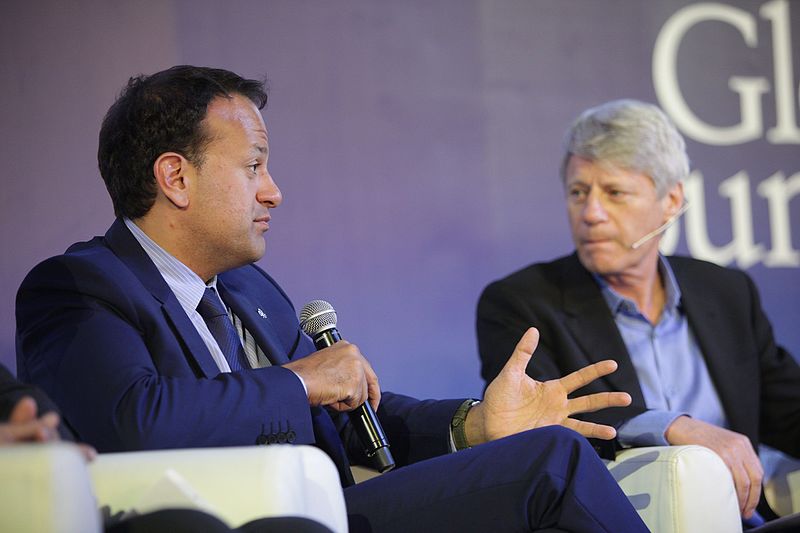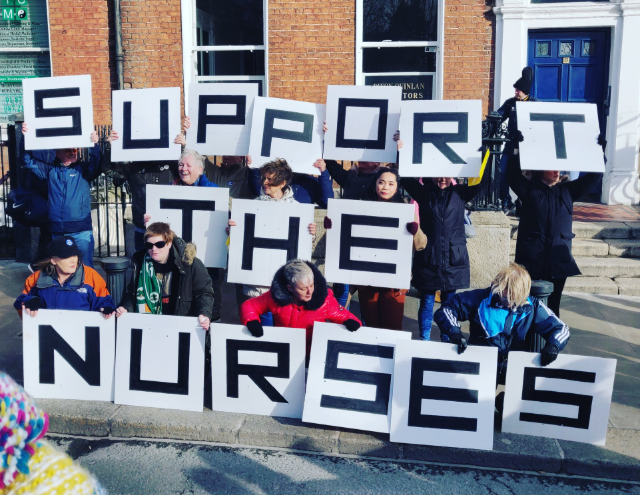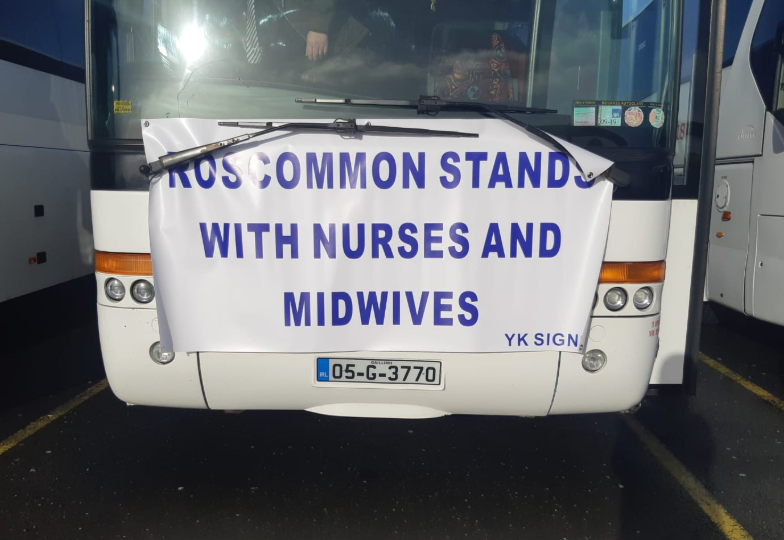On 30 January, nurses and midwives across Ireland staged their first walkout in 20 years over the question of patient safety and pay. Of more than 40,000 nurses organised in the Irish Nurses and Midwives Organisation (INMO), 95 percent voted in favour of strike action. They were joined by the Psychiatric Nurses Association (PNA).
The strike is symptomatic of an explosive class anger developing across Ireland. But two weeks later, the pathetic deal that INMO have returned with shows the role that the trade union bureaucracy are determined to play in smothering this anger.
Years of attacks
The nurses’ strike follows years of attacks across the board, throughout which the trade unions have strained every nerve and fibre to hold back their members. For the ruling class, therefore, the nurses’ dispute was an ominous development. No longer can the torrent be kept at bay. Behind this crack in the dam they sensed a seething rage that has accumulated in the Irish working class over a decade.
The nurses were demanding a 12 percent pay increase, which is modest seeing that the government has imposed a wage freeze since 2008. However, things went much deeper than pay. With nurses underpaid and unable to keep up with the cost of living (especially spiralling rents), the health service has faced a recruitment crisis. Chronic understaffing is regularly leading to scenarios where a single nurse is forced to do the work of two nurses for 13-hour shifts. In a word, the nurses were standing up and shouting, “Enough!”
As one desperate, drained and angry senior nurse explained to the Irish Times:
“Hospital management don’t come near the patient! It’s me! I take their anger and their tears and their frustration. And it has taken its toll. I am done making excuses for our health service and apologising to very sick, scared people for the hospital cancelling their surgery because of something I have no control over. There are no beds, there are not enough nurses. I am helpless to help them. Enough is enough.” (Irish Times, 28 Jan 2019)
With the Irish economy once more “booming” it is scarcely believable that pay restraint – justified as an “emergency” measure since 2008 – cannot now be broken, 11 years later!. But for the ruling class this is not an option. Whilst the economy is booming, state debt remains at €201 billion and workers are still expected to pay for the last crisis.
Moral blackmail
As much as they may wish to have avoided a confrontation, the ruling class were completely unable to give in to the nurses. As an article in The Irish Times (7 Feb 2019), titled “Why the Government cannot give in on the nurses’ strike”, explained:
“At the heart of this dispute is the sense among nurses that they were mugged during the financial crash [...] The banks broke the country and they ended up paying. [...] Their attitude to the Government is: give me back the money you took. The teachers are following, watching closely. Defence Forces personnel are edging ahead of them in the queue. [...] So, from the Government’s perspective, this is about more than just the nurses; this is about its entire public pay policy. Giving up on that is the same as giving up on the budget, and a government that can’t budget can’t govern.”
 In spite of the wave of anger they unleashed, the ruling class was unable to totally give in to the nurses, in whose action it saw an existential threat / Image: World Travel Tourism Council
In spite of the wave of anger they unleashed, the ruling class was unable to totally give in to the nurses, in whose action it saw an existential threat / Image: World Travel Tourism Council
These are astute words from a mouthpiece of the Irish ruling class. If the government had given in on this issue, where would it have ended? Perhaps with the government itself being swept away by a wave of class struggle.
Their weakness was revealed by contradictory steps at each turn. We have seen moral blackmail (“the nurses are putting patient lives at risk!”) at the same time as faux-sympathy. We have seen threats being issued and immediately retracted.
Simon Harris, the health minister, threatened the nurses with forfeiting the miserly pay rise previously agreed upon: “You cannot lodge a cost-rising claim for the duration of the agreement and derive the benefits of the agreement.” A few days later, however, Leo Varadkar was forced to back off, claiming that the while agreements had “technically” been broken it would be “provocative and counter-productive” to apply sanctions now.
Sell-out deal
The problem was the nurses’ cause is tremendously popular with the public and therefore anything the government did was wrong. The nurses had huge support and appeared to be primed to deliver the government a knock-out blow. And yet the INMO leadership came to the government’s rescue.
On Monday 11 February – with the movement on a high after a huge demonstration in Dublin – strike action was suspended following a pay recommendation from the Labour Court. What did the deal entail? Essentially nurses would be given a 2.5 percent rise. Meanwhile, a number of things already agreed in last year’s Public Service Stability Agreement (PSSA) were newly packaged as “concessions”. In exchange, the nurses would pay for this in “productivity increases” – which is another word for working more and harder. In other words, the flogging to death of already overworked nurses!
 The nurses had huge support and appeared to be primed to deliver the government a knock-out blow. And yet the INMO leadership came to the government’s rescue / Image: INMO
The nurses had huge support and appeared to be primed to deliver the government a knock-out blow. And yet the INMO leadership came to the government’s rescue / Image: INMO
Sucking the momentum out of the movement, the INMO leadership decided not to actually give members a vote on this deal until next month! The sense of impotent rage and betrayal nurses and midwives feel has reduced many to tears of anger. One Facebook user expressed these raw feelings:
“As I sit here writing this I have tears running down my cheeks… I am 17 years qualified and I work in a busy critical care unit. I have been active in INMO for years and have sat on the strike committee, I encouraged colleagues to vote yes so we could as a united group proceed with our strike action and I was foolish enough to believe in our union the INMO. What a mistake that was!!”
The sell-out by the leadership may cause confusion and anger at first but at a certain stage there will be questioning. Why has this happened? Why would a trade union leadership in a position of strength surrender? The answer leads right back to the role that trade unions play under a capitalist system in crisis, and raises the need for the complete regeneration of these organisations as weapons of class struggle.
Trade unions in the epoch of imperialist decay
In one of his last articles, entitled “Trade Unions in the Epoch of Imperialist Decay” (1940), Leon Trotsky explained how, in the period of the decay of capitalism, there is a tendency for the trade union bureaucracy to “draw closely to and grow together with the state power.”
This process, Trotsky explained, is a result of the fact that capitalism can no longer grant reforms and instead demands counter-reforms. The trade union leader that clings to the illusion of reforming capitalism through “respectably” trying to “influence” the state becomes instead – consciously or unconsciously – the direct agent of the state in the workers’ movement:
“Monopoly capitalism is less and less willing to reconcile itself to the independence of trade unions. It demands of the reformist bureaucracy and the labour aristocracy who pick the crumbs from its banquet table, that they become transformed into its political police before the eyes of the working class.”
How graphically that process is illustrated in Ireland today! The current situation flows logically from a policy that has existed unchanged for decades. Prior to 2008, the major unions operated on the basis of “social partnership”. This policy was essentially one of open class collaboration and begging for breadcrumbs to be cast down from the bosses’ table.
The policy was lubricated with all sorts of perks and social bribery for a layer of trade union bureaucrats. But with a union leadership that feathered its own nest and just accepted whatever management demanded of it, union density fell between 1995 and 2007 from 53 percent to just 32 percent.
After 2008 however, “social partnership” was discarded… not by the trade unions, but by the bosses! After bailing out the banks and property speculators, the ruling class now demanded that the workers foot the bill in the form of pay cuts, redundancies and by looting of pensions. Very quickly, they found themselves facing a massive backlash. In 2009, a quarter-of-a-million public sector workers went out on strike. However, as quickly as it began it was called off and in 2010, the trade union leaders were brought on board and “emergency measures” agreed, which would restore a kind of economic equilibrium for capitalism.
The deal was a rotten one. In exchange for agreeing to hold back workers from industrial action the union leaders “won” pay freezes, millions of hours of unpaid overtime and – worst of all – the division of workers into a “two tier” system. New workers would now start on far lower rates of pay than existing staff. It was an utter sell-out but it was also the logical extension of “social partnership” into this new period of crisis.
The initial agreement in 2010 was renewed in 2013 and again in 2015. For a period they more or less held out. With a complete absence of fighting leadership, the trade unions had been turned into tools for paralysing the building anger of the working class. But this artificial class peace, buttressed by the trade union tops, could only go so far. Eventually the pressure from below was going to become too much. With the economy once more booming at a galloping pace, workers are no longer prepared to accept that the cupboards are bare.
Cracks in the dam
In 2018, the government and the unions have attempted to blow new life into their agreement. The new “Public Service Stability Agreement” (PSSA) is a direct continuation of these past policies of austerity. With anger seething from below, it was more important than ever to the trade union leaders that they maintain a common front against the workers’ building discontent. When INMO – under pressure – broke ranks and threatened to strike, it angered the other trade union leaders who saw this as making their own jobs infinitely more difficult.
The biggest public service union, Fórsa, in a newsletter to members insinuated that any victory for nurses would come at its own members’ conditions and that industrial action was therefore irresponsible: “Fórsa is on record to say that it, therefore, expects all the parties to the agreement, including employers and other unions, to abide by the terms of the deal in the same way.”
Addressing the government, they warned of “pressure for further pay claims in the health sector and elsewhere if some groups of workers were to be granted pay benefits beyond those set out in the Public Service Stability Agreement (PSSA)”. This is their real message to the government: “Do not give in to the nurses because if you do you are going to make our job of holding back workers much more difficult!”
This is what “social partnership” has resolved itself into: a partnership of the bosses and the trade union bureaucracy against the workers.
Lions led by donkeys
With capitalism in crisis and unable to afford reforms, what alternative is left? Trotsky answered this long ago too:
“Impossible are the independent or semi-independent reformist trade unions. Wholly possible are revolutionary trade unions, which not only are not stockholders of imperialist policy but which set as their task the direct overthrow of the rule of capitalism.”
 Without the paralysing effect of the trade union bureaucracy, the working class could easily do away with this government / Image: INMO
Without the paralysing effect of the trade union bureaucracy, the working class could easily do away with this government / Image: INMO
There are only two types of trade union possible today: one which polices the working class; and one which mobilises the working class for a revolutionary offensive against capitalism.
The fact that the overwhelming majority of the trade union leaders in Ireland today have accepted the former route is the more unforgivable when we consider the tremendous traditions of revolutionary trade unionism, as laid down by James Connolly and James Larkin.
As Connolly explained, the real way to win reforms is through struggle against capitalism: “If the workers ask for the capitalist baker’s shop, he will throw the loaves at them to keep them out.”
And despite everything, the ruling class remains fearful that even the semblance of a concession that they have made to the nurses might be enough to unleash a wave of class struggle. The Irish Times expressed this in an article shortly after action was called off:
“While the proposed agreement is nowhere near the 12 per cent sought by nurses, there are fears in Government that other public sector unions will follow the nurses’ example.” (Irish Times, 12 Feb 2019)
The first task urgently posed is one of cleansing the leadership of the trade union movement of all careerist elements; of introducing full union democracy and ending bureaucratic privilege. Converted into class struggle organisations, coordinated strike action building up to a public sector general strike would bring the bosses’ FG-FF government to its knees.
Without the paralysing effect of the trade union bureaucracy, the working class could deal with this government as easily as swatting a fly.

